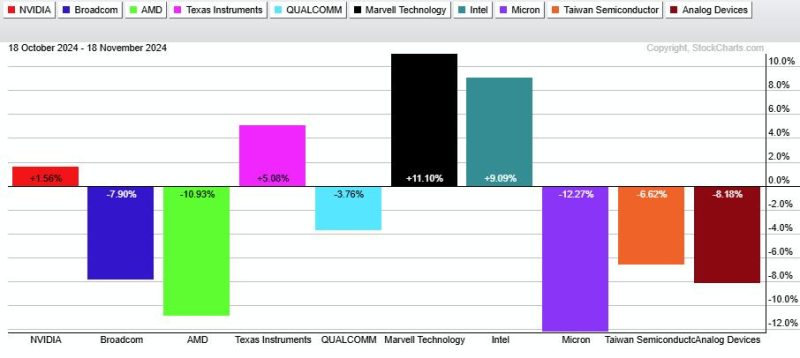In recent times, the semiconductor industry has been subjected to various challenges and factors that have impacted the performance of ETFs focused on this sector. Two prominent semiconductor ETFs, SMH and SOXX, have demonstrated varying degrees of resilience in the face of market fluctuations. Understanding the reasons behind why SMH has held up better than SOXX can provide valuable insights for investors seeking exposure to this dynamic industry.
1. **Composition and Holdings**: One key aspect that sets SMH apart from SOXX is its composition and holdings. SMH, the VanEck Vectors Semiconductor ETF, has a more diversified mix of semiconductor companies compared to SOXX, the iShares PHLX Semiconductor ETF. SMH includes a broader range of companies involved in various aspects of the semiconductor industry, such as manufacturing, design, and equipment. This diversified approach helps SMH mitigate risks associated with individual companies and sectors within the semiconductor industry, thereby contributing to its relative stability.
2. **Market Capitalization**: Another factor that contributes to SMH’s better performance is the market capitalization of its holdings. SMH tends to have exposure to larger, more established semiconductor companies with higher market capitalizations compared to SOXX. These larger companies often have more resources, stronger balance sheets, and greater market share, which can make them more resilient during market downturns. Additionally, larger market capitalizations can attract more institutional investors, providing further support to SMH’s performance.
3. **Global Supply Chain Dynamics**: The semiconductor industry is known for its complex global supply chain, and disruptions in this chain can have significant implications for ETF performance. SMH’s holdings are spread across companies that have a diverse geographic footprint, which can help mitigate risks associated with regional disruptions or geopolitical tensions. In contrast, SOXX may be more exposed to specific regions or countries, making it more vulnerable to supply chain disruptions or regulatory challenges in those areas.
4. **Performance Metrics and Valuation**: When analyzing the performance of semiconductor ETFs, factors such as price-to-earnings ratios, earnings growth rates, and other valuation metrics play a crucial role. SMH’s components may exhibit more attractive valuation metrics compared to SOXX, which can make them more appealing to investors looking for value opportunities. Additionally, fundamental factors such as revenue growth, profit margins, and return on equity can also contribute to SMH’s relative outperformance compared to SOXX.
5. **Industry Trends and Technological Shifts**: The semiconductor industry is constantly evolving, driven by technological advancements, emerging trends, and changing consumer preferences. ETFs that can adapt to these trends and position themselves to benefit from technological shifts are more likely to withstand market volatility. SMH’s diversified approach and exposure to companies at the forefront of innovation in the semiconductor space may provide it with a competitive edge over SOXX in capturing growth opportunities and adapting to industry changes.
In conclusion, the tale of these two semiconductor ETFs, SMH and SOXX, highlights the importance of considering factors such as composition, market capitalization, global supply chain dynamics, performance metrics, and industry trends when evaluating the resilience and performance of ETFs in the semiconductor sector. As investors navigate the complexities of the semiconductor industry, understanding the nuances that differentiate ETFs like SMH and SOXX can help them make informed investment decisions and capitalize on the dynamic opportunities within this evolving sector.
